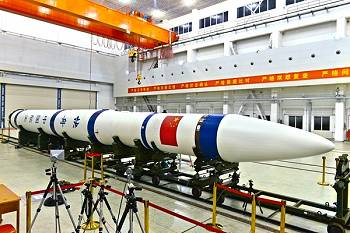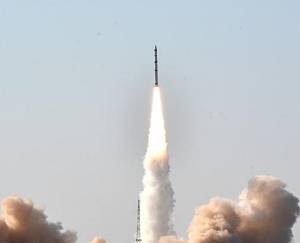| Space Launch Report: Kuaizhou Data Sheet | ||||||||||||||||||||||||||||||||||||||||||||||||||||||||||||||||||||||||||||||||||||||||||||||||||||||||||||||||||
| Home On the Pad Space Logs Library Links | ||||||||||||||||||||||||||||||||||||||||||||||||||||||||||||||||||||||||||||||||||||||||||||||||||||||||||||||||||
 Kuaizhou Kuaizhou
First Image of Kuaizhou, Provided by Xinhua on 11/23/2014
China launched a previously unknown quick response orbital launch vehicle named "Kuaizhou" ("Quick Vessel") on September 25, 2013 from Jiuquan Satellite Launch Center. Liftoff occurred at 04:37 UTC. The specific launch site was not announced. A small satellite named "Kuaizhou 1", identified to be a "natural disaster monitoring satellite", was inserted into a 276 x 193 km x 96.65 deg orbit during the launch. Kuaizhou is believed to be a small solid fuel based launched vehicle developed by China Aerospace Science and Industry Corporation (CASIC). It may be based on the DF-21/25 or DF-31 solid fuel ballistic missiles already in China's inventory. Since those missiles are road mobile, the launch may have been performed from a mobile transporter erector launcher from a flat pad at Jiuquan. China attempted to develop a DF-31 based solid fuel orbital launch vehicle named KT-1
about ten years ago, but KT-1 failed in two test flights. The country then developed
a DF-21 based ASAT launch vehicle named KT-2 that it used to destroy a satellite in orbit
in 2007. On May 13, 2013, China launched another unknown solid fuel rocket on an
extremely high altitude suborbital launch from XiChang. China launched the second quick response orbital launch vehicle named "Kuaizhou" ("Quick Vessel") on November 21, 2014 from Jiuquan Satellite Launch Center. The rocket boosted a "disaster monitoring satellite", according to China's Xinhua, named Kuaizhou 2 into a 293 x 298 km x 96.56 deg orbit after a 06:37 UTC liftoff. The first Kuaizhou launch from the same site occurred on September 25, 2013. No photos of either launch were initially released. Photos of the second launch vehicle in a hangar and being launched were made available on November 23, 2014. Kuaizhou is believed to be a small solid fuel based launched vehicle developed by China Aerospace Science and Industry Corporation (CASIC). It may be based on the DF-21/25 or DF-31 solid fuel ballistic missiles already in China's inventory. Since those missiles are road mobile, the launch may have been performed from a mobile transporter erector launcher from a flat pad at Jiuquan.  Kuaizhou
uses grid fins at the base of its first stage to provide, or augment, initial steering.
It may have three solid stages and a fourth, potentially liquid insertion stage.
The fourth stage of propulsion may be built in to the satellite. Kuaizhou
uses grid fins at the base of its first stage to provide, or augment, initial steering.
It may have three solid stages and a fourth, potentially liquid insertion stage.
The fourth stage of propulsion may be built in to the satellite.
China attempted to develop a DF-31 based solid fuel orbital launch vehicle named KT-1 about ten years ago, but KT-1 failed in two test flights. The country then developed a DF-21 based ASAT launch vehicle named KT-2 that it used to destroy a satellite in orbit in 2007. On May 13, 2013, China launched another unknown solid fuel rocket on an extremely high altitude suborbital launch from XiChang. It was the year's 75th known orbital launch attempt and the 12th by China. Five of the world's last 10 orbital attempts were performed by China.
Vehicle Configurations
* GEO:
Geosynchronous Earth Orbit
Epsilon Launch Log
EPSILON ORBITAL SPACE LAUNCH LOG
DATE VEHICLE ID PAYLOAD MASS(t) SITE* ORBIT*
------------------------------------------------------------------------------------
09/25/13 Kuaizhou 01 Kuaizhou JQ LEO/S
11/21/14 Kuaizhou 02 Kuaizhou 2 JQ LEO/S
------------------------------------------------------------------------------------
Site Code:
JQ = Jiuquan, China
Orbit Code:
EEO/M = Molynia (12-hr) Elliptical Earth Orbit
FTO = Failed to Orbit
FSO = Failed Suborbital
GTO = Geosynchronous Transfer Orbit
GTO+ = Supersynchronous or High Perigee Transfer Orbit
GTO- = Subsynchronous Transfer Orbit
GTOi = Inclined GTO
GEO = Geosynchronous Orbit
HCO = Heliocentric (solar) Orbit
HTO = High Earth Transfer Orbit
LEO = Low Earth Orbit
LEO/S = Sun Synchronous Low Earth Orbit
LEO/P = Polar Low Earth Orbit
MEO = Medium Earth Orbit
MTO = Medium Earth Transfer Orbit
SUB = Suborbital
xxx
References
Xinhua News Reports, 2013-14 Last Update: December 09, 2014 |
||||||||||||||||||||||||||||||||||||||||||||||||||||||||||||||||||||||||||||||||||||||||||||||||||||||||||||||||||